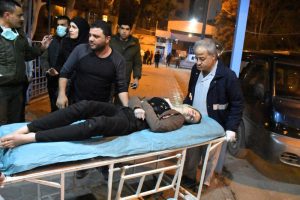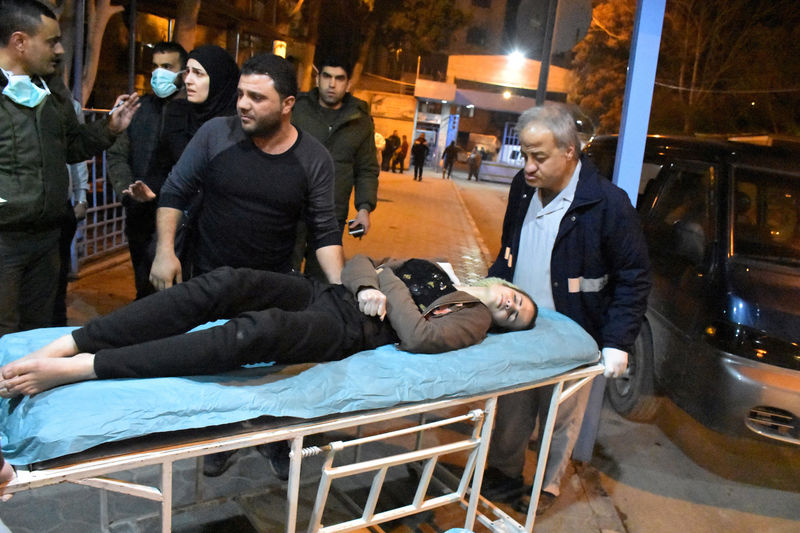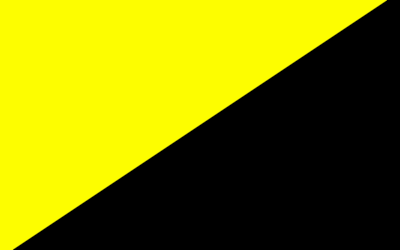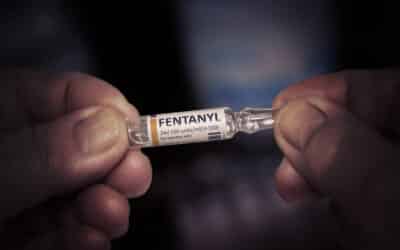The Syrian Observatory for Human Rights (SOHR) says the Saturday evening armed opposition/Hayat Tahrir al-Sham (HTS) mortar attack on three districts in government-held Aleppo did involve chemical gas. Over 100 people were hospitalized by what was widely reported to be a chlorine attack.
According to SOHR, as reported by Reuters: “In Aleppo city which the government controls, the shells had spread a strong stench and caused breathing problems, the Syrian Observatory for Human Rights also said.”
It’s significant that SOHR should confirm this as western media have long relied upon the UK-based opposition source as a go-to outlet for reporting Syria. It is tantamount to the “mainstream” Syrian opposition media essentially agreeing that the Damascus-Russia interpretation of events in this case is true, despite Turkey-backed FSA groups denying the charge.

SANA/Handout via REUTERS: “A woman lies on a stretcher after what the Syrian state media said was a suspected toxic gas attack in Aleppo, Syria November 24, 2018.”
The broader public which is unfamiliar with the history of chemical weapons reporting and investigation inside Syria might be scratching their heads at this one, perhaps thinking: “wait I thought only Assad possessed and has used chemical weapons!?!”
Well, at least that’s the basic assumption of pretty much all past mainstream media reporting. Anytime the rebel side claimed a chemical attack going back to at least 2013, journalists have uncritically parroted and amplified rebel claims without investigation or what would pass for evidence by OPCW/U.N. standards (OPCW officials have in the past stated that social media videos produced by the rebels and White Helmets organization can never be taken as stand alone evidence).
* * *
Below is a partial list of both United Nations and mainstream media admissions which have been largely buried and forgotten, but which are crucial evidence highlighting that the armed opposition has from the beginning utilized chemical munitions against the Syrian Army and Syrian civilians.
The Wall Street Journal 12/13/2013
“The final U.N. investigation into alleged chemical weapons use in Syria has found that chemical weapons were conclusively used in one incident and were likely used in four other alleged attacks, including three in which government troops were the victims of sarin gas. It was the first time the U.N. has reported that Syrian military personnel may have been the target of a chemical-weapon attack in the course of the 33-month-old conflict…”
“The fact that the report names government soldiers as victims raised the possibility that rebel groups may have had access to sarin gas, which the Syrian government, and its allies Iran and Russia, have long maintained.”
“Chemical weapons were used repeatedly in the Syria conflict this year, not only in a well-documented Aug. 21 attack near Damascus but also in four other instances, including two subsequent attacks that targeted soldiers, the United Nations said in a report released Thursday…”
“The report said the panel had corroborated “credible allegations” that chemical weapons were used in the first reported attack — a March 19 episode involving soldiers and civilians [as victims] in Khan al-Assal in the country’s north.”
United Nations final December 2013 report investigating East Ghouta and four other sites
“The United Nations Mission remains deeply concerned that chemical weapons were used in the ongoing conflict between the parties in the Syrian Arabic Republic, which has added yet another dimension to the continued suffering of the Syrian people.”
[For context, I noted the following in 2013: The report states that chemical weapons were “probably used” at five sites in Syria during the two-and-a-half year long conflict. Most significant is that at two sites, the victims were Syrian government soldiers, and at another, the victims were regime soldiers and civilians (for initial BBC reporting go here). While the purpose of the investigation was not to establish the culprit in each attack, the report identifies the victims in three out of the five incidents as regime soldiers. This is a tacit UN admission that the rebels possess and have used chemical weapons.]
U.S. State Dept. Travel Advisory for Syria, updated 10/2017
“Tactics of ISIS, Hayat Tahrir al-Sham, and other violent extremist groups include the use of suicide bombers, kidnapping, small and heavy arms, improvised explosive devices, and chemical weapons.”
“They have targeted major city centers, road checkpoints, border crossings, government buildings, shopping areas, and open spaces, in Damascus, Aleppo, Hamah, Dara, Homs, Idlib, and Dayr al-Zawr provinces.”
* * *
But even prior to the UN’s December 2013 findings, credible allegations of rebel chemical weapons were nothing new. In May of 2013, Carla Del Ponte, a top UN human rights investigator and former UN Chief Prosecutor and veteran International Criminal Court attorney – was the first to accuse the rebels of using Sarin gas against government forces and civilians (also see here, here, and here).
This is what a top U.N. investigator had to say the very first time she weighed in publicly on CW usage in Syria…































